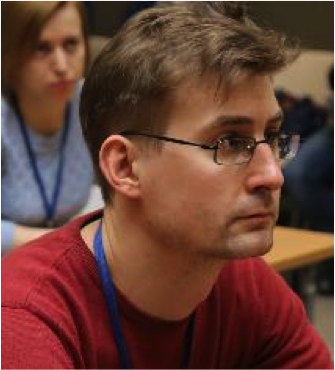
Sergey S. Shapovalov
Head of Laboratory, Ph.D. (Chemistry)
- Streamlined synthesis and stereochemistry of heterometallic clusters based on the concept of Hoffmann isolobal analogies.
- Synthesis of metal complexes with unusual carbenoids, namely organotellur halides, stannylenes, N-heterocyclic carbenes, organodihalides (arenoruthenium, cyclopentadienyl-cobalt and rhodium, cyclobutadiene-cobalt, rhenium tris-pyrazolylborate and zero-valent platinum complexes, which form sharply shortened platinum–tin and tellurium–metal multiple bound.
- Synthesis and magnetochemistry of heterometallic chalcogen-containing chromium complexes simulating spin-spin interactions in magnetic semiconductors and reactions in nitrogen-fixing enzymes of the MoFeS type of nitrogenase cofactor.
The principle of the stepwise construction of heterometallic complexes was developed, including (i) synthesis of a homometallic complex with functional groups (chalcogenate, halide, carboxylate, beta-diketonate, pyrazolate) and (ii) hence, this complex is attached as a ligand to the atom of another transition metal in its electron-deficient complex, forming a heterometallic complex, binuclear or polynuclear, depending on the ratio of reagents and coordination capabilities of the central metal atom. The predictive capabilities of this heterometallization increase sharply if the introduced organometallic fragments are isolobal, i.e. differ in the nature of metals and ligands in them, but have a similar configuration and energy of boundary orbitals (for example, ferrocenyl and cymanthrenyl; trimethylplatinum and tricarbonylrenium; areneruthenium and cyclopentadienyl rhodium).
Particular attention was paid to the synthesis, structure, and thermal decomposition of chalcogen and tin heterometallic clusters, which in all cases have sharply (0.3 A) shortened partially multiple M–E bonds, probably as a consequence of strong dative transition metal–non-transition element interactions. Due to the strength of such bonds, the composition of the metal core is preserved during pyrolysis, allowing for the production of inorganic compounds usually containing difficult-to-combine elements (for example, tin and tungsten).
Based on the synthesis of heterometallic platinum-containing clusters and their thermal decomposition, highly efficient nanoscale catalysts for the reduction of molecular oxygen in methanol-air fuel cells and the processing of rapeseed oil into hydrocarbons were obtained.
- Elena Yu. Buslaeva Leading Researcher, Dr. of Sciences (Chemistry)
- Sergey P. Gubin Head Researcher, Dr. of Sciences (Chemistry)
- Julia V. Ioni Researcher, Ph.D. (Chemistry)
- Sergey G. Sakharov Leading Researcher, Dr. of Sciences (Chemistry)
- Ivan V. Skabitsky Senior Researcher, Ph.D. (Chemistry)
- Yury V. Torubaev Leading Researcher, Dr. of Sciences (Chemistry)
Postgraduate Students
- Yulia A. Groshkova
- Olga G. Tikhonova
- A. Pasynskii, I.V. Skabitsky, Yu.V. Torubaev, A.V. Pavlova, S.S. Shapovalov, O.G. Tikhonova, S.G. Sakharov. CpFe(CO)2TePh as a ligand for organometallic dihalides Fe(CO)4I2, (p-Cymene)RuI2 and Me5C5RhI2: Synthesis and molecular structures // Russian Journal of Coordination Chemistry. 2017. V. 43(1). p. 44–49.
- A. Pasynskii, S.S. Shapovalov. The role of inner- and outer-sphere ligands in pivalate and cymantrenecarboxylate complexes of transition metals // Russian Journal of Coordination Chemistry. 2016. V. 42(9). P. 574–583.
- S. Shapovalov, A.A. Pasynskii, Yu.V. Torubaev, I.V. Skabitskii, M. Scheer, M. Bodensteiner. Stannylene complexes of manganese, iron, and platinum // Russian Journal of Coordination Chemistry. 2014. V. 40(3). P. 131–137.
- A. Pasynskii, Yu.V. Torubaev, A.V. Pavlova, I.V. Skabitsky, G.L. Denisov, V.A. Grinberg. Synthesis and molecular structure of redox active platinum-bis(telluroferrocenyl) complex and its chelate with rhenium-chloro(tricarbonyl) // Journal of Cluster Science. 2015. V. 26(1). p. 247–255.
- V. Torubaev, A.A. Pasynskii, A.V. Pavlova, M. Tauqeer, R.H. Herber, I. Nowik, I.V. Skabitskii, G.L. Denisov, V.A. Grinberg, P. Mathur, M.M. Shaikh, G.K. Lahiri. Synthesis, molecular structures, Mössbauer and electrochemical investigation of ferrocenyltelluride derivatives: (Fc2Te2)Fe(CO)3I2[(CO)3IFe(μ-TeFc)]2, CpFe(CO)2TeFc, CpFe(CO)2TeX2Fc (X = Br, I) and CpFe(CO)2(μ-TeFc)Fe(CO)3I2 // Journal of Organometallic Chemistry. 2015. V. 777(2). p. 88–95.
- Blokhin, A. Pasynskii, M. Scheer, A. Virovets, Yu. Torubaev. Synthesis and molecular structure of mixed-metal stannylene derivatives of cyclopentadienyl-(nitrosyl)(carbonyl) manganese // Journal of Organometallic Chemistry. 2013. V. 724. p. 75–81.
- V. Torubaev, A.A. Pasynskii, P. Mathur. Organotellurium-halides: New ligands for the transition metal complexes // Coordination Chemistry Reviews. 2012. V. 256(5–8). p. 709–721.
- Pasynskii. Formation of shortened partially multiple bonds of transition metals with carbenoid compounds of heavy p-elements of Groups III–VII as a reason for the occurrence of the HSAB principle // Russian Journal of Coordination Chemistry. 2011. V. 37(10). p. 801-811.
- Dixneuf, A. Blokhin, X. Miao, A. Pasynskii, S. Nefedov. Alkylidene-ruthenium-tin catalysts for the formation of fatty nitriles via cross-metathesis of plant oil derivatives with acrylonitrile // Organometallics. 2010. V. 29. p. 5257–5262.
- A. Pasynskii, I.V. Skabitsky, Yu.V. Torubaev, S.G. Sakharov, S.S. Shapovalov. Synthesis and structure of mixed-metal thiolate complex Cp′Cr(CO)2(μ-SBu)Pt(PPh3)2: Side-on-coordination of Cr–S double bond with platinum // Journal of Organometallic Chemistry. 2009. V. 694(21). p. 3373–3375.
- A. Pasynskii, Yu.V. Torubaev, V.N. Grigor’ev, A.I. Blokhin, M. Herberhold, P. Mathur. The shortened transition metal-tellurium bonds in organometallic clusters // Journal of Cluster Science. 2009. V. 20(1). p. 193–204.
- A. Pasynskii, Yu.V. Torubaev, I.V. Skabitsky, S.S. Shapovalov – MAIK Science/Interperiodica Award in Chemistry for the series of articles “Heterometallic Chalcogenide and Stannylene Clusters: Chemical Design and Structural Features” published in the journal Russian Journal of Coordination Chemistry (2015)
Grants of the Russian Science Foundation
- 17-73-10503. Synthesis and study of structure of carbene complexes as precursors of nanoscale materials (2017–2018)
Grants of the Russian Foundation for Basic Research
- 16-03-00798. Isolobal heterometallization: chemical design and transformations of complexes with metal-containing ligands (2016–2018)
- 12-03-33101. Role of electronic effects in conversion of metal-containing ligands in clusters (2012–2013)
RF President grants for State Support of Young Scientists
- MK 5105.2015.3. Laws of formation, structure, and thermal decomposition of transition metal complexes with heterocyclic carbenes as precursors of inorganic materials (2015–2016)
- MD 7122.2012.3. Streamlined synthesis of transition metal complexes with hypervalent organotelluride halide ligands as precursors of materials with physically significant properties (2012–2013)
- MK 7179.2012.3. Synthesis, structure, and catalytic reactions of stannylene complexes of transition metals with strong metal-tin bonds (2012–2013)
- Topchiev Institute of Petrochemical Synthesis RAS (Moscow)
- Nikolaev Institute of Inorganic Chemistry, Siberian Branch RAS (Novosibirsk)
- University of Regensburg (Germany)
- Indian Institute of Technology Bombay (India)